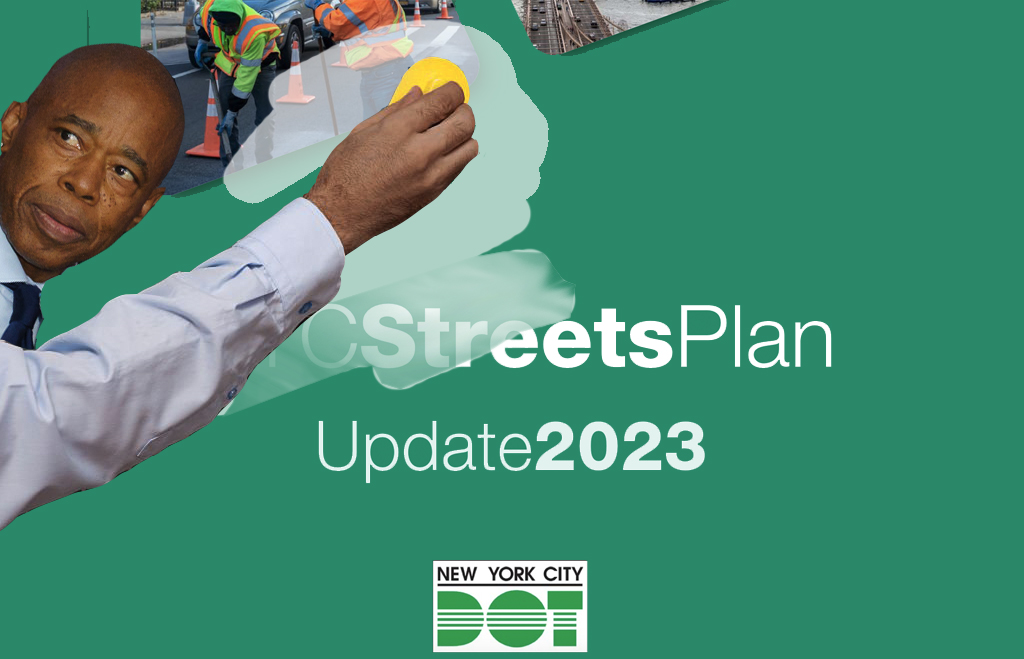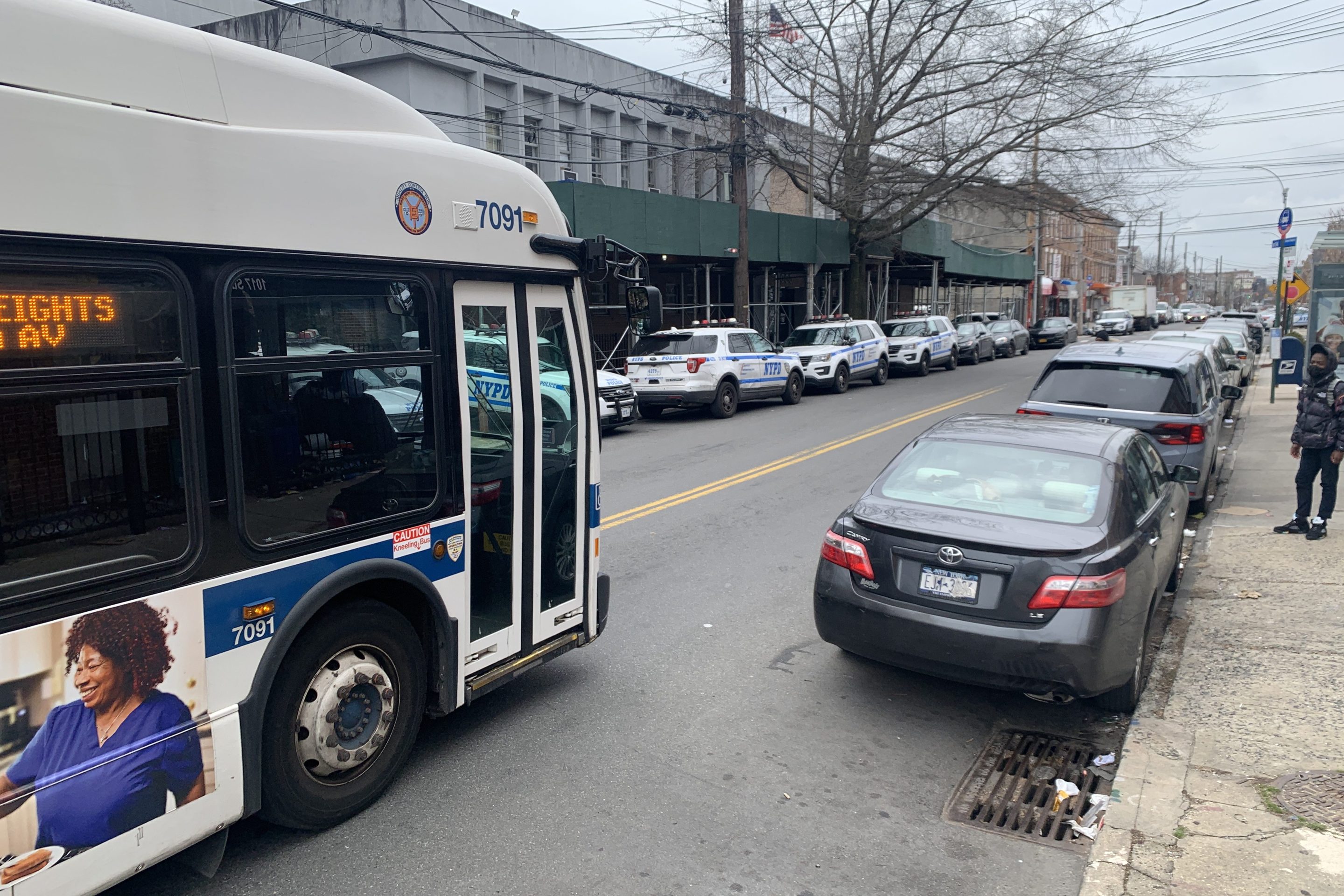In 2023, Mayor Adams failed spectacularly in meeting a legal mandate to construct 50 miles of protected bike lanes and 30 miles of protected or "enhanced" bus lanes. It was the second consecutive year that the two-year-old Adams administration fell short of the targets required under a 2019 law.
What happens now? Nothing. And therein lies the problem.
Concocted by then-Council Speaker Corey Johnson, the 2019 Streets Master Plan law [PDF] said it would usher in "a safer, more livable, and more equitable city" by establishing clear benchmarks to guide street design policy beyond the whims of mayors and fickle Council members and community boards that too often seek to block popular bike- and bus-lane policies.
The promise of the law has met the reality of the Adams administration. Far from meeting the established benchmarks, the city under Mayor Adams has run away from high-profile fights, delayed and slow-walked contentious projects and failed to adequately staff DOT.
Rather than the comprehensive, connected bike and bus lane network the master plan was supposed to herald, the city under Adams has made arbitrary decisions on which political objections it considers valid and which it considers unimportant — saddling communities across the city with subpar infrastructure in the process.
The law was passed by the City Council and signed by then-Mayor Bill de Blasio — but neither runs the city Department of Transportation. If 2023 taught street safety activists anything, it's that the Streets Master Plan law may only be as binding as the mayor wants.
What was supposed to happen?
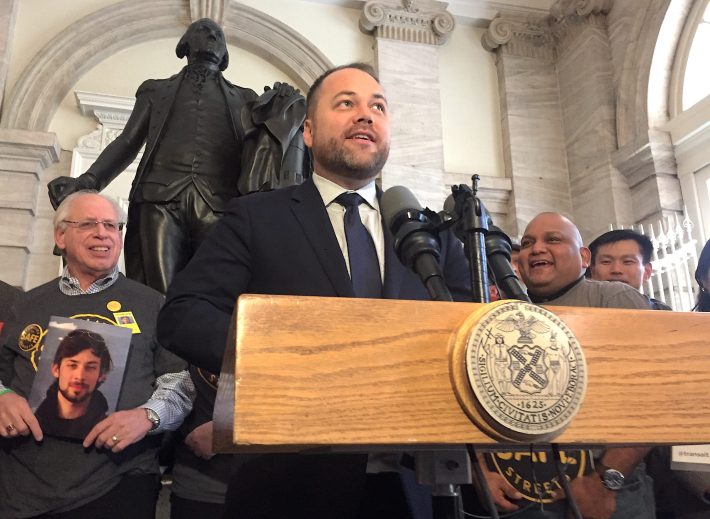
To understand where the Streets Master Plan went wrong, it's important to take a step back. In 2019, then-Speaker Johnson put transportation front and center of his legislative agenda with the release of his "Let's Go" plan.
In it, Johnson proposed that the city take over the operation of the subway from the MTA. He also proposed that the city install 250 miles of protected bike lane and 150 miles of bus lanes in five years, while adding much more pedestrian space around the five boroughs.
Three months later, Johnson introduced the bill (happily co-sponsored by then-Transportation Committee Chair and now-DOT Commissioner Ydanis Rodriguez) that would require the city to hit mileage benchmarks.
Johnson often talked about "breaking car culture." To do so, he pledged to shift the city from a piecemeal safety approach that typically reacts to tragedy and external pressure into something proactive that strove for connected networks and a new philosophy towards the way the city used the street and curb.
It was no accident that Johnson was the face of the master plan, since as the New York Times noted when it passed, he was "expected to run for mayor in 2021." (More on that later.)
Even as then-Mayor Bill de Blasio agreed to sign the bill, there were some issues with the law outside the Council's direct control, namely funding. Then-DOT Commissioner Polly Trottenberg made it clear in her testimony on the bill that a DOT expected to far surpass its previous road redesign benchmarks would need more than marching orders.
The DOT needed "significant additional funding from the city budget, which we estimate to be several billion dollars, new head count, new facilities, and equipment" Trottenberg said at the time.
The agency would need to expand its ability to do in-house road striping work, she said — and to spend significantly less time negotiating terms and scrapping projects at the behest of unelected community boards.
Left unsaid at the time in Council hearings, rallies and hosannas once it passed was that the law would also need a mayor interested in executing the plan — without any enforcement mechanism, the next mayor would need to buy in.
So what happened?
Someone, either Mike Tyson or Joseph Stalin, once said "Everybody has a five-year plan until they get hit in the face." And that aphorism has been applicable to the Streets Master Plan in the two years since it went into effect.
For starters, New York became the epicenter of the coronavirus pandemic, which wreaked havoc on the city budget during the exact time the DOT was getting ready to release and then implement the streets plan.
The pandemic upended city politics in some ways that benefited the goals of the plan. Open streets and outdoor dining became fast examples of pedestrianization and curb reform that didn't destroy the city, and candidates for mayor made appeals for votes at transit-themed forums and debates and on bike rides with reporters.
But none of those candidates was Corey Johnson, the actual guy who came up with the streets master plan. And without him in Gracie Mansion, some government and advocacy veterans saw a tough future for the plan.
"My way of thinking about street master plan is that it's an artifact of Corey Johnson's mayoral bid from 2019," said Jon Orcutt, a former DOT official under Mayors Bloomberg and de Blasio.
"And I think if Corey was the mayor, he would have laid down all these markers. But that didn't happen."
Even so, when Eric Adams won the 2021 mayoral race, he did so with a platform that talked about bringing real "bus rapid transit" to the city and a 300-mile connected network of protected bike lanes. Adams answered the DOT's call for funding for the plan by allocating $904 million to implement the five-year plan in his first budget. He even appointed Rodriguez, himself a big booster of the master plan, as the city's Transportation Commissioner.
The Adams Master Plan
In the waning days of the de Blasio administration, the DOT did deliver a Streets Master Plan that promised to guide cycling, walking and transit development for the next five years. It had maps to dream on and ambitious ideas and, oh yeah, a $1-billion price tag.
Money was only one piece of the equation, though. To get a citywide network of protected bike and bus lanes, plus huge increases in public plazas, would mean relying more than ever on planners and construction crews.
But the DOT couldn't fill existing vacancies in 2022 due to across the board budget cuts that Adams instituted when he took office. Making matters worse, the agency began losing employees dissatisfied with return-to-office mandates, leadership at the agency and political interference in projects.
By the end of Adams's first year, the DOT told the MTA it wouldn't be able to hit the target of 150 miles of bus lanes by the end of 2026 — mostly, it claimed, because of those staff shortages.
Political meddling also slowed down the completion in 2022 of a bus lane on Northern Boulevard in Queens and any forward progress on upgrading the Fordham Road bus lane in the Bronx — both key projects for not just hitting the streets plan goals but speeding up buses on notoriously clogged corridors.
But if 2022 was a quietly disappointing year, 2023 was the year Adams showed true disregard for the legal benchmarks in the master plan. Projects lived or died based on his nebulous ideas of community support. Some disappeared for no reason. Corey Johnson's notion of comprehensive, politics-free planning seemed to go out the window:
- Bike lanes on McGuinness Boulevard and Ashland Place had key pieces lopped off at the behest of well-connected donors.
- A trio of bike lanes in East New York went in despite the community board and City Council Member Charles Barron opposing them.
- The DOT abandoned a plan for an offset bus lane on Fordham Road at the behest of the Council Member Oswald Feliz and big money interests, but finished the Gun Hill Road bus lane despite Council Member Kevin Riley announcing his opposition to it.
- The Bedford Avenue protected bike lane was shown to community boards, won support from Council Member Chi Ossé and then disappeared. The DOT held one meeting on the Flatbush Avenue bus lane in January and the project was never seen again.
- The city finished almost all the work on a bike boulevard on Underhill Avenue, only for City Hall to pause the work for more community outreach after two years of outreach.
The mayor canceling multiple projects is demoralizing on its own, but it also adds up to mileage missing from the DOT's yearly targets and forces the agency to spend time on allegedly settled matters instead of doing new projects.
In terms of bike lane mileage, curtailing or disappearing Bedford Avenue, Underhill Avenue and pieces of McGuinness Boulevard and Ashland Place adds up to 2.4 miles of missing protected bike lanes. Axing Fordham Road's upgrade means the mayor decided against 3 miles of bus lanes needed under the master plan law.
It was after the mess on Underhill Avenue (in which the mayor also revealed he still owned a co-op in the neighborhood he claimed to have sold) that Adams began explicitly promising to slow things down to the point of going door to door to get feedback on the project. Despite two years at the head of the table, the mayor suddenly decided the public outreach on street redesigns he was in charge of wasn't good enough.
If anything, the administration that prioritized politics above street projects leaned in harder to that process this year. City Hall appointees, like longtime Adams adviser Ingrid Lewis-Martin and veteran Brooklyn Borough Hall apparatchik turned City Hall land use official Richard Bearak have been slowing down or axing DOT projects despite no formal role overseeing the DOT.
Even before the mayor told DOT employees he didn't see bus lane and bike lane projects as part of his legacy, it became obvious that even with aggressive benchmarks to hit, nothing had changed in terms of the seeming arbitrary nature of deciding which projects go in and which projects languish.
Adams may have inherited the master plan law, but beyond the fact that he promised to meet or even exceed it, he's responsible for implementing it because it's the law.
"The mayor is on the hook," said Riders Alliance Director of Communications and Policy Danny Pearlstein. "If you successfully become the mayor, you have to govern, especially if you've made these lofty promises, it's on you alone. And you can't point fingers at somebody like Oswald Feliz: 'I couldn't do my job because Oswald Feliz said no.' No, that's not life. If you give him a veto, that's your fault."
Bus priority on Fordham Road and Flatbush Avenue matters, beyond slow bus speeds, because they're corridors that tens of thousands of people can use to access the subway if they live in neighborhoods without those connections.
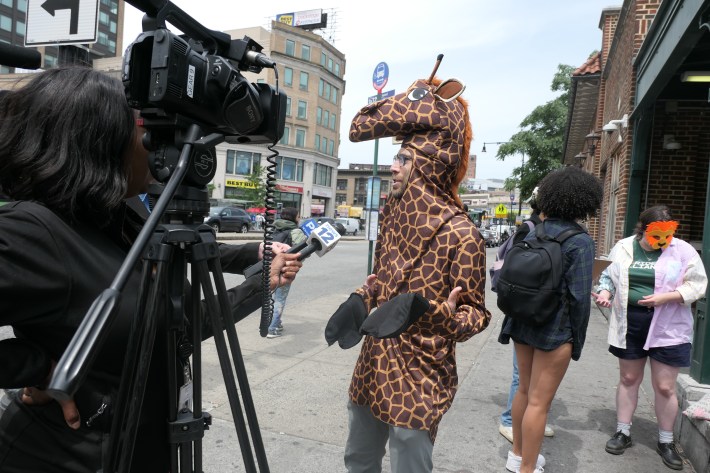
McGuinness Boulevard wasn't just a badly needed redesign of a dangerous street drivers use as a cut through between highway exits. A full protected bike lane on the corridor would also create a network running between Meeker Avenue, the Pulaski Bridge and the developing Long Island City protected bike lane network.
Similarly on Ashland Place, the lopped off edge east of Lafayette Street doesn't just create a baffling and dangerous crossing for cyclists. It also robs the project of its ability to make a contiguous lane from Fourth Avenue to the Manhattan and Brooklyn bridges and the east-west Flushing Avenue bike lane and north Brooklyn waterfront.
"The plan was to get out of that trench warfare. It was for the city to say, 'We are doing this, and here's where we're going to do it over the next few years, and it's coming. So talk about some details with us, but it's coming.' You would still need an administration willing to say that to everybody, not necessarily a transactional-at-all-times mayoralty," said Orcutt.
Big ideas, little execution
And as the mayor neglects major pieces of the plan, the big ideas behind it are also suffering.
As Johnson laid it out, the Streets Master Plan was also about rethinking the street grid to, for example, deal with an explosion of home delivery even before the pandemic and to find better uses for the curb than just car parking.
Most of those pieces of have gone missing or are mired in delays as well.
The city promised a couple of pilots to cut down on double-parked delivery drivers using streets as staging areas. One is a one-year pilot for sidewalk storage lockers from GoLocker, where UPS drivers can drop off packages instead of leaving them in apartment building foyers. Those lockers do not exist, per GoLocker's website which lists only locations inside a handful of stores in the city.
The other is a microdelivery hub pilot where larger trucks could unload deliveries to cargo bikes or hand trucks for residential delivery. But after the DOT said it was aiming to open up to 20 microdelivery hubs in the summer or fall of 2023, there was no forward movement on the hubs.
It's been over a year since a roving Oonee pilot provided a month of secure bike parking in various neighborhoods and since the Department of Citywide Administrative Services put out a request for expressions of interest that sought, among other things, a vendor to build secure bike parking in the city. Jersey City and the Port Authority are pedaling circles around New York when it comes to secure bike parking, something the city has been working on with no results for almost a decade now.
And placard reform and enforcement, that biggest idea of all that simply requires a mayor to say "Stop misusing your city-issued placards" has completely fallen off the edge of the Earth. The DOT included "Major Placard Reform" as a "Transformative Idea" in the debut edition of the streets plan. The term, and the word "placard," is missing entirely in the 2023 edition.
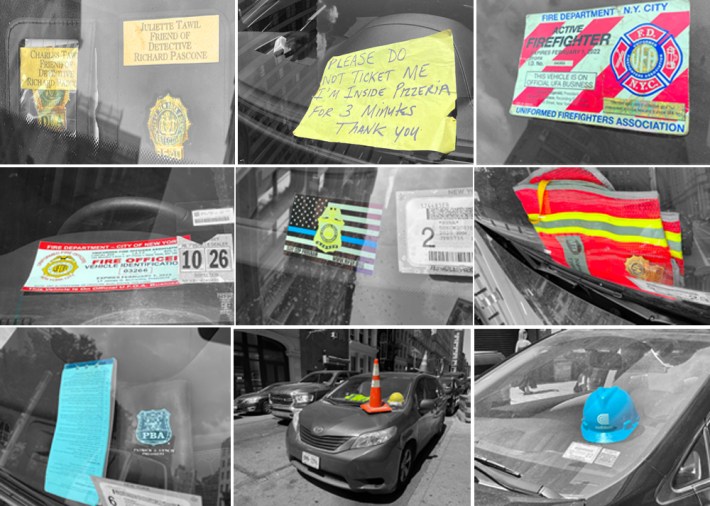
What's next?
A Streets Master Plan that no one bothers to live up to can undermine the DOT in a couple of ways. One, it obfuscates the good work the agency does in a given year. And two, the law becomes a kind of useless appendage that makes a mockery of even having a vision.
"You don't want legislation just hanging there that is never going to be met," said Regional Plan Association Executive Vice President Kate Slevin. "It just undermines the role of any master planning effort. To put a big vision out there with specific targets, and then you don't meet any of them, it's not really good for anyone involved."
The City Council has registered its disapproval, but little else, via Transportation Committee Chairwoman Selvena Brooks-Powers.
"Thirty-plus miles of completed new bike lane is of course better than none, but falls far short of Streets Plan requirements," Brooks-Powers said in a statement issued a week after the DOT and the mayor put out end-of-year press releases touting their accomplishments. "We must do more on bus lane targets. Bus lane targets were not even mentioned in the recent progress announcement, which is yet another reminder of the Department of Transportation’s consistent failure to be transparent about their progress toward adhering to the law over the course of the year."
City Council Speaker Adrienne Adams did not say what the Council might do to get the administration to comply with the law.
"Achievement of the Streets Master Plan benchmarks, including the completion of bike and bus lane miles, is a critical step towards street safety in New York City," a City Council spokesperson said in a statement. "We echo Majority Whip Brooks-Powers’ statement about the Council’s commitment to investments in safe, equitable, and accessible transportation and holding the Administration accountable to the requirements of the law."
The Council lacks tools to force the mayor to act on the law — which of course, is the problem at the core of the Streets Master Plan.
Mayor Adams at this point has a choice. Be the mayor who punts every street design to a political functionary for approval, or be the mayor who follows meets the challenge of the law he has to implement. If he chooses the former, we'll need another mayor to let the streets plan live up to its full potential.
The DOT did not respond to multiple questions about the Streets Master Plan. Johnson did not respond to a call seeking comment.
